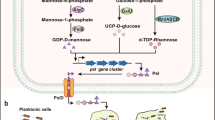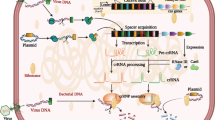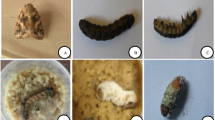Abstract
Yersinia pestis is a dangerous bacterial pathogen that can cause plague. Both RovA and cyclic AMP receptor protein (cAMP-CRP) are required for regulating biofilm- and virulence-related genes in Y. pestis. In this study, the transcriptional regulation between RovA and cAMP-CRP were analyzed by using primer extension, quantitative RT-PCR, LacZ fusion, and electrophoretic mobility shift assay. The results indicated that RovA repressed crp transcription in an indirect manner, while that RovA had no regulatory action on cyaA at the transcriptional level. In addition, cAMP-CRP did not regulate the transcription of rovA. Taken together with our previous results, complex regulatory interactions of RovA, cAMP-CRP, and PhoP/PhoQ in Y. pestis were revealed, which would promote us gain deeper understanding about coordinative modulation of biofilm- and virulence-related regulator genes.




Similar content being viewed by others
References
Zhou D, Yang R (2011) Formation and regulation of Yersinia biofilms. Protein Cell 2:173–179
Han Y, Qiu J, Guo Z, Gao H, Song Y, Zhou D, Yang R (2007) Comparative transcriptomics in Yersinia pestis: a global view of environmental modulation of gene expression. BMC Microbiol 7:96
Cathelyn JS, Crosby SD, Lathem WW, Goldman WE, Miller VL (2006) RovA, a global regulator of Yersinia pestis, specifically required for bubonic plague. Proc Natl Acad Sci USA 103:13514–13519
Dube PH, Handley SA, Revell PA, Miller VL (2003) The rovA mutant of Yersinia enterocolitica displays differential degrees of virulence depending on the route of infection. Infect Immun 71:3512–3520
Nagel G, Heroven AK, Eitel J, Dersch P (2003) Function and regulation of the transcriptional activator RovA of Yersinia pseudotuberculosis. Adv Exp Med Biol 529:285–287
Derbise A, Chenal-Francisque V, Pouillot F, Fayolle C, Prevost MC, Medigue C, Hinnebusch BJ, Carniel E (2007) A horizontally acquired filamentous phage contributes to the pathogenicity of the plague bacillus. Mol Microbiol 63:1145–1157
Zhang Y, Wang L, Fang N, Qu S, Tan Y, Guo Z, Qiu J, Zhou D, Yang R (2013) Reciprocal regulation of pH 6 antigen gene loci by PhoP and RovA in Yersinia pestis biovar Microtus. Future Microbiol 8:271–280
Liu L, Fang H, Yang H, Zhang Y, Han Y, Zhou D, Yang R (2016) Reciprocal regulation of Yersinia pestis biofilm formation and virulence by RovM and RovA. Open Biol 6:150198
Heroven AK, Dersch P (2006) RovM, a novel LysR-type regulator of the virulence activator gene rovA, controls cell invasion, virulence and motility of Yersinia pseudotuberculosis. Mol Microbiol 62:1469–1483
Zhan L, Han Y, Yang L, Geng J, Li Y, Gao H, Guo Z, Fan W, Li G, Zhang L et al (2008) The cyclic AMP receptor protein, CRP, is required for both virulence and expression of the minimal CRP regulon in Yersinia pestis biovar microtus. Infect Immun 76:5028–5037
Oh MH, Lee SM, Lee DH, Choi SH (2009) Regulation of the Vibrio vulnificus hupA gene by temperature alteration and cyclic AMP receptor protein and evaluation of its role in virulence. Infect Immun 77:1208–1215
Petersen S, Young GM (2002) Essential role for cyclic AMP and its receptor protein in Yersinia enterocolitica virulence. Infect Immun 70:3665–3672
Rickman L, Scott C, Hunt DM, Hutchinson T, Menendez MC, Whalan R, Hinds J, Colston MJ, Green J, Buxton RS (2005) A member of the cAMP receptor protein family of transcription regulators in Mycobacterium tuberculosis is required for virulence in mice and controls transcription of the rpfA gene coding for a resuscitation promoting factor. Mol Microbiol 56:1274–1286
Skorupski K, Taylor RK (1997) Cyclic AMP and its receptor protein negatively regulate the coordinate expression of cholera toxin and toxin-coregulated pilus in Vibrio cholerae. Proc Natl Acad Sci USA 94:265–270
Busby S, Ebright RH (1999) Transcription activation by catabolite activator protein (CAP). J Mol Biol 293:199–213
Kim TJ, Chauhan S, Motin VL, Goh EB, Igo MM, Young GM (2007) Direct transcriptional control of the plasminogen activator gene of Yersinia pestis by the cyclic AMP receptor protein. J Bacteriol 189:8890–8900
Liu H, Wang H, Qiu J, Wang X, Guo Z, Qiu Y, Zhou D, Han Y, Du Z, Li C et al (2009) Transcriptional profiling of a mice plague model: insights into interaction between Yersinia pestis and its host. J Basic Microbiol 49:92–99
Zhan L, Yang L, Zhou L, Li Y, Gao H, Guo Z, Zhang L, Qin C, Zhou D, Yang R (2009) Direct and negative regulation of the sycO-ypkA-ypoJ operon by cyclic AMP receptor protein (CRP) in Yersinia pestis. BMC Microbiol 9:178
Willias SP, Chauhan S, Lo CC, Chain PS, Motin VL (2015) CRP-mediated carbon catabolite regulation of Yersinia pestis biofilm formation is enhanced by the carbon storage regulator protein, CsrA. PLoS ONE 10:e0135481
Liu L, Fang H, Yang H, Zhang Y, Han Y, Zhou D, Yang R (2016) CRP is an activator of Yersinia pestis biofilm formation that operates via a mechanism involving gmhA and waaAE-coaD. Front Microbiol 7:295
Groisman EA (2001) The pleiotropic two-component regulatory system PhoP-PhoQ. J Bacteriol 183:1835–1842
Rebeil R, Jarrett CO, Driver JD, Ernst RK, Oyston PC, Hinnebusch BJ (2013) Induction of the Yersinia pestis PhoP-PhoQ regulatory system in the flea and its role in producing a transmissible infection. J Bacteriol 195:1920–1930
Vadyvaloo V, Viall AK, Jarrett CO, Hinz AK, Sturdevant DE, Hinnebusch J, B (2015) Role of the PhoP-PhoQ gene regulatory system in adaptation of Yersinia pestis to environmental stress in the flea digestive tract. Microbiology 161:1198–1210
Liu L, Fang N, Sun Y, Yang H, Zhang Y, Han Y, Zhou D, Yang R (2014) Transcriptional regulation of the waaAE-coaD operon by PhoP and RcsAB in Yersinia pestis biovar Microtus. Protein Cell 5:940–944
Oyston PC, Dorrell N, Williams K, Li SR, Green M, Titball RW, Wren BW (2000) The response regulator PhoP is important for survival under conditions of macrophage-induced stress and virulence in Yersinia pestis. Infect Immun 68:3419–3425
Grabenstein JP, Fukuto HS, Palmer LE, Bliska JB (2006) Characterization of phagosome trafficking and identification of PhoP-regulated genes important for survival of Yersinia pestis in macrophages. Infect Immun 74:3727–3741
Bozue J, Mou S, Moody KL, Cote CK, Trevino S, Fritz D, Worsham P (2011) The role of the phoPQ operon in the pathogenesis of the fully virulent CO92 strain of Yersinia pestis and the IP32953 strain of Yersinia pseudotuberculosis. Microb Pathog 50:314–321
Zhang Y, Wang L, Han Y, Yan Y, Tan Y, Zhou L, Cui Y, Du Z, Wang X, Bi Y et al (2013) Autoregulation of PhoP/PhoQ and positive regulation of the cyclic AMP receptor protein-cyclic AMP complex by PhoP in Yersinia pestis. J Bacteriol 195:1022–1030
Zhang Y, Gao H, Wang L, Xiao X, Tan Y, Guo Z, Zhou D, Yang R (2011) Molecular characterization of transcriptional regulation of rovA by PhoP and RovA in Yersinia pestis. PLoS ONE 6:e25484
Zhou D, Tong Z, Song Y, Han Y, Pei D, Pang X, Zhai J, Li M, Cui B, Qi Z et al (2004) Genetics of metabolic variations between Yersinia pestis biovars and the proposal of a new biovar, microtus. J Bacteriol 186:5147–5152
Sun F, Gao H, Zhang Y, Wang L, Fang N, Tan Y, Guo Z, Xia P, Zhou D, Yang R (2012) Fur is a repressor of biofilm formation in Yersinia pestis. PLoS ONE 7:e52392
Sun F, Zhang Y, Qiu Y, Yang H, Yang W, Yin Z, Wang J, Yang R, Xia P, Zhou D (2014) H-NS is a repressor of major virulence gene loci in Vibrio parahaemolyticus. Front Microbiol 5:675
El-Robh MS, Busby SJ (2002) The Escherichia coli cAMP receptor protein bound at a single target can activate transcription initiation at divergent promoters: a systematic study that exploits new promoter probe plasmids. Biochem J 368:835–843
Liu Z, Gao X, Wang H, Fang H, Yan Y, Liu L, Chen R, Zhou D, Yang R, Han Y (2016) Plasmid pPCP1-derived sRNA HmsA promotes biofilm formation of Yersinia pestis. BMC Microbiol 16:176
Fang N, Qu S, Yang H, Fang H, Liu L, Zhang Y, Wang L, Han Y, Zhou D, Yang R (2014) HmsB enhances biofilm formation in Yersinia pestis. Front Microbiol 5:685
Acknowledgements
This work was supported by the National Natural Science Foundation of China (81801984), and by the Natural Science Foundation of Hubei Province (2018CFB184), and by the Hubei Province health and family planning scientific research project (WJ2018H0070).
Author information
Authors and Affiliations
Corresponding authors
Electronic supplementary material
Below is the link to the electronic supplementary material.
Rights and permissions
About this article
Cite this article
Liu, L., Fang, H., Ding, Y. et al. Transcriptional Regulation Between the Two Global Regulators RovA and CRP in Yersinia pestis biovar Microtus. Curr Microbiol 75, 1634–1641 (2018). https://doi.org/10.1007/s00284-018-1571-4
Received:
Accepted:
Published:
Issue Date:
DOI: https://doi.org/10.1007/s00284-018-1571-4




